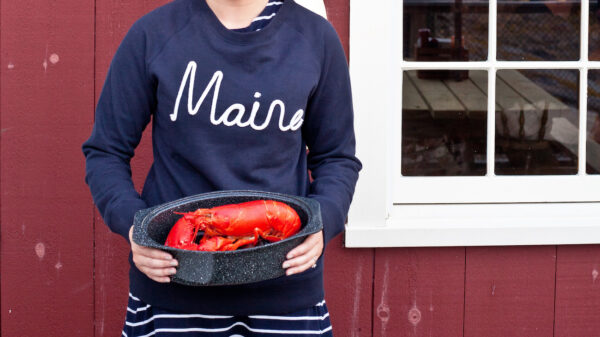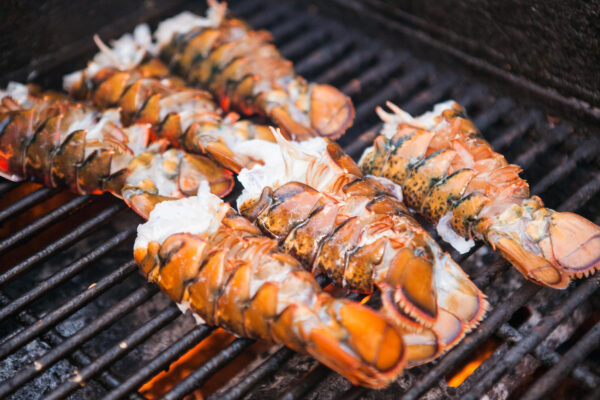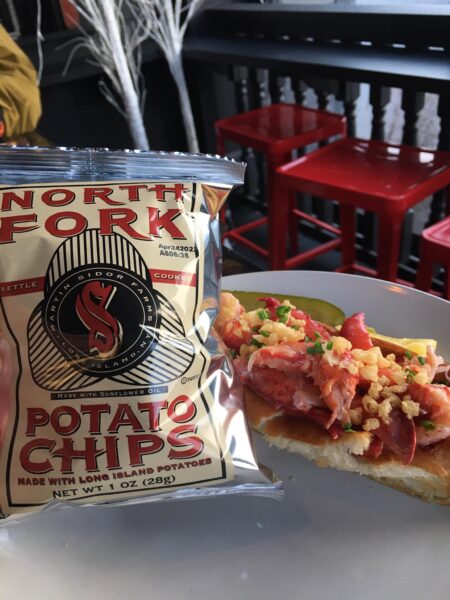If you’re going to be vacationing in Southern Maine, then you’ll want to learn how to cook lobster. Thankfully, Lisa MarcAurele, blogger at Little Bit Recipes and cookbook author based in Connecticut, has shared some easy-to-follow instructions.
This includes tips on selecting your lobster, the best cooking techniques and serving suggestions to make your meal successful.

Photo credit: Adobe Photos.
Before we moved to Maine full time, we rented our house to vacationers through a management company. As we were shopping to stock our kitchen, they made sure we had plenty of tools available for people to cook lobster. This included:
- one to two large lobster pots
- tongs
- lobster crackers
- seafood forks
Selecting lobsters that you’re going to cook
When selecting the perfect lobster, there are several factors to consider. First and foremost, it’s important to choose a fresh live lobster.
Fresh lobsters will have lively tails and claws that move when touched or picked up. You should also check that the tail and claws are intact and firm.
You also want to handle live lobsters carefully, as they can pinch very hard. That’s why you’ll see them in the market with rubber bands on their claws. This protects you from their claws.
Some meat markets in Maine that take EBT may also sell live lobsters.
What you need to know about lobster
Lobster is a popular seafood delicacy, especially in Maine. However, you don’t need to be a chef to cook it properly. To cook a lobster like a pro, you must first understand some basic facts.
Also, it’s important to note that there are different types of lobsters. However, for our purposes, we’re focusing on cold-water Maine lobster. They happen to be the most common type in North America and a New England specialty.
FYI, the other kind of American lobster is the spiny lobsters. These are the lobsters that live in the warmer waters of the Southeastern United States.
Buying live lobsters
When buying live lobsters, choose those that feel heavy for their size and show signs of life, like moving their antennae, tail, or legs. If you’re not cooking them immediately after purchase, store them in a cool place with damp newspaper or seaweed on top of the ice to keep them moist.
Another factor to consider when selecting your lobster is size. Larger lobsters yield more meat, but smaller ones can also be delicious and more affordable. It’s also important not to overlook the claw size; larger claws typically contain more meat than smaller ones.
Lastly, consider where you’re getting your lobsters from. Purchase lobsters directly from local fishermen or fish markets rather than grocery stores to get the freshest.
Preparing lobster for cooking
It’s essential to keep the lobster alive right before cooking. Otherwise, you risk the chance of bacteria spreading through the lobster’s body. Plus, if you eat lobster meat contaminated with bacteria, you’re likely to get food poisoning.
Use a sharp knife or kitchen shears to carefully remove the rubber bands around the claws while holding the lobster firmly around its back. You don’t want to cook the lobster with its claws still banded. At the same time, if you hold a lobster like this, you should stay safe from getting pinched.
If you’d rather not handle an active lobster, placing lobsters in the freezer for five to 10 minutes will sedate them and dull their senses. That way, you can kill each lobster humanely before cooking by placing it on a cutting board with its belly down and plunging a sharp broad knife between the first joint and the eyes to split the head in half.
Boiling lobsters
The most common way to cook live lobsters is to boil them in a pot of salted water until the shell turns bright red. Many prefer serving it with melted butter or dipping sauces like garlic butter or cocktail sauce.
For boiling, fill a large pot with water and bring the water to a rolling boil. Add salt or other seasonings if desired.
Once the water has reached a boil, carefully add the lobsters, head first, one at a time, using tongs or gloves. Then, once you have the lobsters in the pot, cover most of the top to bring the water back to a boil quickly.
After that and once your water is boiling again, cover the pot and set your timer. Boil for seven to 10 minutes for one- to 2-pound lobsters, or up to 20 minutes for larger ones. A general rule of thumb for boiling lobsters is seven minutes for the first pound and three minutes for each additional pound.
Once the lobster shell is bright red, then you’ll know that the meat has fully cooked. If unsure, use a meat thermometer. You’ll want to see a reading of at least 135°F (57°C).
How to cook lobster on the grill
Before you grill lobster, you must kill it first. The best way to do this is by numbing it in the freezer and slicing its head in half from the back.
Once killed, you can grill the whole lobster or cut it in half. If halved, you can also remove any unwanted parts, such as the tomalley (green liver) or roe (eggs), before cooking.
If you are cooking lobster halves, brush olive oil or melted butter on the flesh side of the lobster and place them on a preheated grill with high heat, flesh side down first. Grill for five to seven minutes per side until the meat is opaque and firm.

Grilled lobsters. Photo credit: Adobe Photos.
“A tip for beginners that will minimize the chances of overcooking the lobster meat is to parboil the lobsters before prepping them, ” says Jack Slobodian of JackSlobodian.com. Parboiling basically means precooking until almost done. “Parboiling the lobsters will help the center cook before the outer layer of the meat overcooks from the intense heat of broiling and grilling.”
Baking a lobster
Baking is a great way to prepare lobster, especially if you want a healthier cooking method that requires no added fat. To bake lobster:
- Start by preheating your oven to 375°F.
- Cut the lobster in half lengthwise and remove the tomalley and roe if desired.
- Brush the flesh with melted butter or olive oil and season with salt and pepper.
Place the lobster halves on a baking sheet, shell side down and bake until the meat is cooked. The cooking time for a halved lobster will vary depending on the size of the lobster.
- one-pound lobster, cook for 12 to 15 minutes
- two-pound lobster, cook for 18 to 20 minutes
- three-pound lobster, cook for 24 to 26 minutes
To add flavor, before baking, try stuffing the lobster tail with breadcrumbs mixed with garlic, parsley, lemon zest and parmesan cheese. Adding other ingredients like chopped shrimp or scallops to this mixture will make an even more luxurious meal.
Not sure which seasoning to use? Don’t worry, says Amanda McGrory-Dixon of Burrata and Bubbles. “Lobster meat is sweet and buttery on its own, so you don’t want to cover the meat with too many different spices. Less is more here,” she says. “A little salt and pepper on the tail meat with a lemon-garlic butter on the side is perfection.”
Not sure if your lobster is done? You can check by inserting a meat thermometer into the thickest part of the tail meat. The lobster is done when the internal temperature reaches 135°F.
Steaming
To steam a lobster, you will need a large pot with a steamer insert and enough water to cover the bottom of the pot by about an inch. Bring the water to a boil over high heat before placing the lobsters in the steamer basket and covering them with a lid.
Cooking times for steamed lobsters vary depending on their size. A good rule of thumb is to cook them for 10 to 12 minutes per pound, so if you have two one-and-a-half–pound lobsters, they will take around 15 to 18 minutes. It’s important not to overcook your lobsters, as this can result in tough meat that’s difficult to chew.
When your lobsters are done cooking, remove them from the pot using tongs and let them cool slightly before cracking open their shells and enjoying their succulent meat.
Recap of cooking tips
To ensure your lobster meat comes out the best every time, follow these tips:
- Choose a live lobster that’s fresh and healthy. Look for lobsters that are active and have all their claws intact.
- The key is not to overcook the meat. Once it turns bright red and opaque, it’s done. Overcooking will result in tough, rubbery meat that will be hard to chew. To ensure you don’t overdo it, set a timer or keep an eye on the clock while cooking.
- Once cooked, remove the lobster from the pot using tongs or a slotted spoon.
- Serve your boiled lobster hot but let it cool for a few minutes before cracking open its shells with a nutcracker or kitchen shears.
Serving perfectly cooked lobster
There’s nothing quite like enjoying a delicious lobster meal for a seafood Friday dinner. The rich and succulent flavor of the meat is hard to resist, and it’s even better when cooked to perfection.
To make it easier to eat, you can use kitchen shears to cut the underside of the tail in half. Then pull the tail meat from the inside so it’s out of the shell. You can also remove the body and head of the lobster and serve only the tail and claw sections.
For a lazy lobster, you can remove the meat completely from the shell before serving your fresh lobster at home. Use a lobster cracker or nutcracker to crack the shell.
The most popular way to serve lobsters is with melted butter and lemon wedges. You can also add dipping sauces for a delicious meal that will impress even the pickiest eaters.
Before eating, remove the black intestinal vein that runs through the tail if it wasn’t removed before cooking. You may be familiar with this requirement if you’ve ever cooked fresh shrimp.

Lobster roll and chips. Photo credit: Leah Ingram.
Cooked lobster meat can be used in soups and salads. It works well in pasta dishes, sandwiches (think about the quintessential Maine lobster roll) and countless seafood recipes, too. Or, try adding it to gumbo or a seafood pot pie.
This article originally appeared on Little Bit Recipes.
Free and Cheap Things To Do in Southern Maine This Week
Here are FREE and cheap things to do in Southern Maine in the coming week.